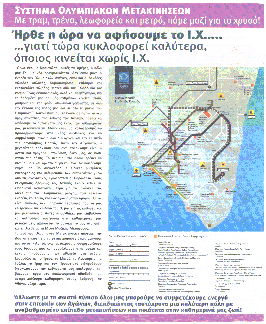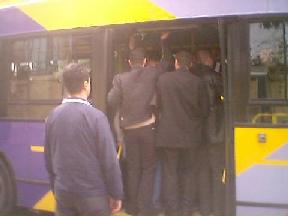
2004 Olympics in Athens are considered a success. Especially the smooth transfer of hundred of thousands of visitors from and to the venues, and throughout the city during the day, was for many people the most pleasurably unexpected achievement in this city most of the time plagued by terrible congestion and bad quality public transport. This was accomplished through a policy consisting to suppress most car movements and to reinforce and give priority to public mass transport media. The metro, the new tram and most of the busses were running till late night (and some of them 24 hours round the clock) and were frequent and abundant. Flyers, radio and TV messages as well as newspaper advertisements encouraged the citizens to leave their cars home and use pubic transport instead.
An example of paper advertisement calling the inhabitants of Athens to leave at home their cars and use pubic transport instead
Police tried genuinely to control illegal parking on sidewalks, squares, pedestrianised streets, parks and other pedestrian spaces. The inhabitants of Athens still remember with nostalgia an image of their city they had never seen before.
Unfortunately this situation didn’t last for long. It seems international olympic committee directions and sponsored show requirements count more for the greek administrations than greek citizens’ safety, health and well being. Little by little the city returned to the previous miserable traffic conditions.
Municipal police trying to legalise by their indifference illegal parking on the new Keramikos pedestrianised area during the post-olympic period
Night buses and metro function was after a little time
abandoned, despite the wishes of the inhabitants and the reactions of many
ecological organisations.

Congested buses turned back after the
olympics
Paradoxically, although the programme for the movements during the olympics was based on public transport media (and proved indeed successful), the vast majority of the olympic traffic projects were new roads and motorways. And these were implemented, although almost in all cases the local population and ecological organisations (and even traffic engineers in some cases) protested.
The Marathon trail is a notable example. Athens has a real advantage over other cities: this city has the original marathon route, connecting the ancient stadium of Athens with the place of the 5th century BC battle. In 1996 for the first time in modern times marathon run has been established to commemorate the victory of ancient Athenians over the Persian invaders, symbolising the victory of free spirit over barbarism. It was indeed an opportunity to transform this trail in a pedestrian corridor (probably with some bicycle facilities) where amateur and professional athletes, joggers or simple walkers could exercise and enjoy. This could also be a tourist attraction.
The fences in the middle of the marathon motorway discourage pedestrians to cross the street, encourage the speeding of vehicles and make the road more dangerous for both pedestrians and cars
But instead of this, the neo-barbarian administrations, despite the reaction and protests of the locals and grassroots organisations, turned this historical stretch into this hubris-motorway splitting apart inhabited areas and villages. The alternative of a rail link capable to absorb the persons’ flow was outside the scope of the administration and (as usually) postponed for the unforeseeable future.
Sprawl (often under the form of illegal building) is the “development” awaiting the areas around the new marathon motorway. Even plain sidewalks are missing
In another road project Kifissos, the river of Athens (actually a torrent), was covered to form another urban motorway. The river flooded twice during the construction period, the summer previous to the games, causing severe damages to the surrounding properties
Kifissos River converted into a culvert to close the so-called “olympic ring” motorway project
According to traffic engineers’ forecasts, most road projects will soon saturate, leaving Athens with the same congestion, but more traffic volumes, noise, pollution and pedestrian unfriendly environment.
This useless grade separated junction running through Psykhiko area is already saturated many hours every day. Supposedly built to alleviate the congestion of the road link from the city centre to the olympic stadium, it is in fact part of the waste-of-money-motorised-traffic-promotion olympic package. Such road bridges on roads leading to the city centre are dubbed by some traffic engineers as "shortcuts to congestion", because they transfer congestion to the next junction, while attract even more traffic to the centre and encourage further car use.
Even some positive (in principle) traffic projects were implemented in a problematic manner. The new tramway is such an example.
The Olympic-winners Park is destroyed by the new tramway course. The nearby 3-lanes per direction roadway was carefully preserved
Although this new medium could contribute to the overall improvement of public transport network, it was implemented in expense rather of pedestrian spaces than of road surface. So, this 400 million investment risks just to substitute several bus lines (some of them electric trolley busses) running in parallel with the tram path, instead of pulling people out of their cars and increasing the public transport share.
This tree in Nea Smyrni area was preserved, although left on the road pavement as a result of sidewalk narrowing, but many thousands of other trees were cut down along the new tramway course
A year after the games, the new tram runs still on improvised and not fixed timetables, with long delays, while the administration has not yet implemented the promised priority over cars on junctions. As a result of poor services, it carries around 35.000 passengers daily, instead of the 80.000 that had initially been predicted.
This is "Neos Kosmos" tram station. It is supposed that these streets are dedicated to the tram path and the pedestrian traffic. Neos Kosmos inhabitants often protest and have demonstrated against the pedestrian rights violations, but the callous administrations hasn't reacted.